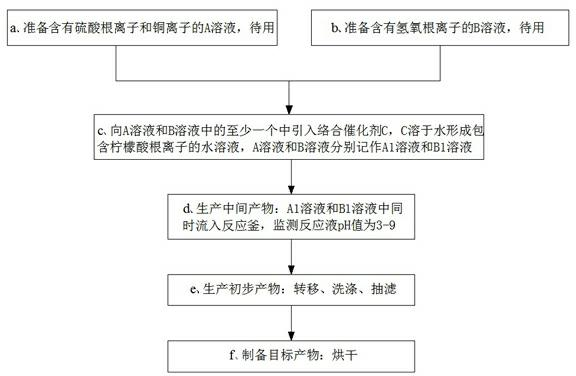Industrial preparation method of alkali copper sulfate
A copper sulfate and basic technology, applied in copper sulfate and other directions, can solve problems such as output limitation, and achieve the effects of improving production efficiency, being conducive to cleaning, and improving purity
- Summary
- Abstract
- Description
- Claims
- Application Information
AI Technical Summary
Problems solved by technology
Method used
Image
Examples
preparation example Construction
[0024] refer to figure 1 , the industrial preparation method of basic copper sulfate of the present invention comprises the following steps:
[0025] a, prepare to contain sulfate ion (SO 4 2- ) and copper ions (Cu 2+ ) A solution, stand-by;
[0026] Specifically, solution A can be directly acidic circuit board copper sulfate waste liquid, so that industrial waste liquid can be directly used to reduce production costs; it can also be copper sulfate solution, or it can be prepared from copper hydroxide, basic copper carbonate, and copper oxide. One or more of them react with sulfuric acid. In the present invention, there is no special requirement to the concentration of A solution, as a kind of preference, in order to give consideration to production cost, production efficiency and productivity, Cu in A solution 2+ The mass concentration is 2%~12%.
[0027] b. Preparation containing hydroxide ions (OH - ) B solution, for use;
[0028] Solution B is a soluble hydroxide s...
Embodiment 1
[0046] Dissolve copper sulfate in reactor No. 1 to form Cu 2+ A solution with a mass concentration of 2% is ready for use; dissolve sodium hydroxide in the No. 2 reactor to form OH - Mass concentration is 5% B solution, stand-by; Add citric acid to A solution, make Cu 2+ with C 6 h 5 o 7 3- The molar ratio is 1:0.01, after that, A solution and B solution are re-recorded as A1 solution and B1 solution respectively; Add 500mL water into the 2L reaction kettle, the water temperature is 35 ℃, A1 solution and B1 solution are simultaneously and slowly It flows into the reactor, and the pH electrode is used to monitor the pH value of the reaction solution in the reactor in real time during the reaction, and determine whether to adjust the flow of the two solutions according to the monitored pH value, so that the pH value of the reaction solution is controlled at about 3 and If it is greater than 3, after a period of continuous reaction, close the A1 solution and B1 solution to p...
Embodiment 2
[0048] Put a certain amount of acidic circuit board copper sulfate waste liquid into the No. 1 reactor to form Cu 2+ A solution with a mass concentration of 7.6% is ready for use; potassium hydroxide is dissolved in the No. 2 reactor to form OH - Mass concentration is 8% B solution, stand-by; Add sodium citrate in A solution, make Cu 2+ with C 6 h 5 o 7 3- The molar ratio is 1:0.3, after that, A solution and B solution are re-recorded as A1 solution and B1 solution respectively; Add 500mL water into the 2L reaction kettle, the water temperature is 50 ℃, A1 solution and B1 solution are simultaneously and slowly Flow into the reaction kettle, use the pH electrode to monitor the pH value of the reaction solution in the reaction kettle in real time during the reaction, and determine whether to adjust the flow of the two solutions according to the monitored pH value, so that the pH value of the reaction solution is controlled at about 5, After continuous reaction for a period ...
PUM
| Property | Measurement | Unit |
|---|---|---|
| particle size | aaaaa | aaaaa |
| particle size | aaaaa | aaaaa |
| particle size | aaaaa | aaaaa |
Abstract
Description
Claims
Application Information
 Login to View More
Login to View More - R&D
- Intellectual Property
- Life Sciences
- Materials
- Tech Scout
- Unparalleled Data Quality
- Higher Quality Content
- 60% Fewer Hallucinations
Browse by: Latest US Patents, China's latest patents, Technical Efficacy Thesaurus, Application Domain, Technology Topic, Popular Technical Reports.
© 2025 PatSnap. All rights reserved.Legal|Privacy policy|Modern Slavery Act Transparency Statement|Sitemap|About US| Contact US: help@patsnap.com



